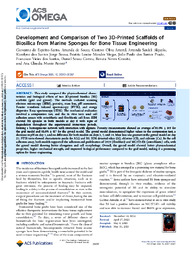Embrapa Instrumentação
Development and Comparison of Two 3D-Printed Scaffolds of Biosilica from Marine Sponges for Bone Tissue Engineering.
Autoria: ESPIRITO SANTO, G. do; SOUZA, A. de; AMARAL, G. O.; ALQUALO, A. S.; SOUSA, K. dos S. J.; VIEGAS, B. L. M.; PRADO, J. P. dos S.; SANTOS, F. V. dos; CORREA, D. S.; GRANITO, R. N.; RENNÓ, A. C. M.
Resumo: This study compared the physicochemical characteristics and biological effects of two 3D-printed biosilica (BS) scaffolds (grid and gyroid). The methods included scanning electron microscopy (SEM), porosity, mass loss, pH assessment, Fourier transform infrared spectroscopy (FTIR), and energy dispersive X-ray spectroscopy (EDS). The mechanical evaluation involved a compression test, and the in vitro tests used cell adhesion assays with osteoblastic and fibroblastic cell lines. SEM showed BS spicules in both models at day 0 with signs of degradation throughout the experimental immersion periods, forming a homogeneous network with interaction with alginate. Porosity measurements showed an average of 85.9% ± 0.9 for the grid model and 83.6% ± 0.7 for the gyroid model. The gyroid model demonstrated higher values in the compression test, a decrease in pH on day 1, and no difference for both models on days 3, 7, and 14. Mass loss was greatest in the gyroid model on day 21. FTIR tests showed characteristic peaks for ALG and BS. EDS detected silica (Si), chlorine (Cl), and calcium (Ca). In the cell adhesion assay, both models supported the adhesion and proliferation of L929 (fibroblast) and MC3T3-E1 (osteoblastic) cells, with the gyroid model showing better elongation and cell morphology. Overall, the gyroid model showed better physicochemical properties, higher mechanical strength, and improved biological performance compared to the grid model, making it a promising option for tissue engineering.
Ano de publicação: 2025
Tipo de publicação: Artigo de periódico
Unidade: Embrapa Instrumentação
